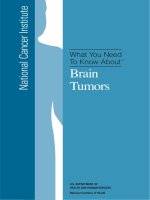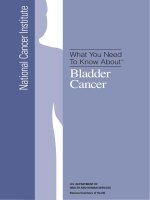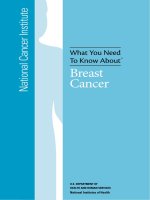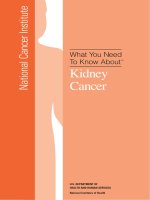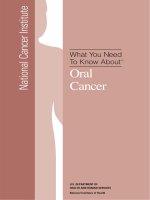What You Need To Know About - Bladder Cancer potx
Bạn đang xem bản rút gọn của tài liệu. Xem và tải ngay bản đầy đủ của tài liệu tại đây (588.36 KB, 43 trang )
National Cancer Institute
What You Need
To Know About
TM
Bladder
Cancer
U.S. DEPARTMENT OF
HEALTH AND HUMAN SERVICES
National Institutes of Health
National Cancer Institute Services
This is only one of many free booklets for
people with cancer.
You may want more information for yourself,
your family, and your doctor.
NCI offers comprehensive research-based
information for patients and their families, health
professionals, cancer researchers, advocates, and
the public.
• Call NCI’s Cancer Information Service at
1–800–4–CANCER (1–800– 422–6237)
• Visit us at or
/>• Chat using LiveHelp, NCI’s instant
messaging service, at />livehelp
• E-mail us at
• Order publications at />publications or by calling 1–800– 4–CANCER
• Get help with quitting smoking at
1–877–44U–QUIT (1–877–448–7848)
U.S. DEPARTMENT OF
HEALTH AND HUMAN SERVICES
National Institutes of Health
National Cancer Institute
Contents
About This Booklet 1
The Bladder 2
Cancer Cells 4
Risk Factors 5
Symptoms 8
Diagnosis 9
Staging 11
Treatment 13
Second Opinion 22
Rehabilitation 23
Nutrition 25
Follow-up Care 26
Sources of Support 26
Taking Part in Cancer Research 28
Dictionary 29
National Cancer Institute Publications 37
About This Booklet
This National Cancer Institute (NCI) booklet is
about cancer* that starts in the bladder.
Each year in the United States, more than 52,000
men and 18,000 women are diagnosed with bladder
cancer. Most are over 70 years old.
1
*Words in italics are in the Dictionary on page 29. The Dictionary
explains these terms. It also shows how to pronounce them.
More than 9 of 10 Americans with bladder
cancer have a type called transitional cell cancer
(TCC). This booklet is about TCC of the bladder.
TCC begins in the cells on the surface of the
inner lining of the bladder. These cells are called
transitional cells. They are able to stretch when
the bladder is full and shrink when it’s emptied.
Learning about medical care for bladder cancer can
help you take an active part in making choices about
your care. This booklet tells about:
• Diagnosis and staging
• Treatment and rehabilitation
• Taking part in research studies
This booklet has lists of questions that you may want
to ask your doctor. Many people find it helpful to take a
list of questions to a doctor visit. To help remember
what your doctor says, you can take notes. You may
also want to have a family member or friend go with
you when you talk with the doctor—to take notes, ask
questions, or just listen.
For the latest information about bladder cancer,
please visit NCI’s Web site at />cancertopics/types/bladder. Also, NCI’s Cancer
Information Service can answer your questions about
cancer. We can also send you NCI booklets and fact
sheets. Call 1–800–4–CANCER (1–800–422–6237)
or chat with us online using LiveHelp, NCI’s instant
messaging service at />The Bladder
Your bladder is a hollow organ in the lower
abdomen. It stores urine, the liquid waste made by the
kidneys.
Your bladder is part of the urinary tract. Urine
passes from each kidney into the bladder through a
long tube called a ureter. Urine leaves the bladder
through a shorter tube (the urethra).
The wall of the bladder has layers of tissue:
• Inner layer: The inner layer of tissue is also called
the lining. As your bladder fills up with urine, the
transitional cells on the surface stretch. When you
empty your bladder, these cells shrink.
• Middle layer: The middle layer is muscle tissue.
When you empty your bladder, the muscle layer in
the bladder wall squeezes the urine out of your
body.
• Outer layer: The outer layer covers the bladder. It
has fat, fibrous tissue, and blood vessels.
2
3
Kidney
Ureter
Bladder
Prostate
Urethra
This picture shows the bladder and nearby organs in a
man.
Kidney
Ureter
Urethra
Bladder
This picture shows the bladder and nearby organs in a
woman.
Cancer Cells
Cancer begins in cells, the building blocks that make
up tissues. Tissues make up the bladder and the other
organs of the body.
Normal cells grow and divide to form new cells as
the body needs them. When normal cells grow old or
get damaged, they die, and new cells take their place.
Sometimes, this process goes wrong. New cells
form when the body doesn’t need them, and old or
damaged cells don’t die as they should. The buildup of
extra cells often forms a mass of tissue called a growth
or tumor.
Tumors in the bladder can be benign (not cancer) or
malignant (cancer). Benign tumors are not as harmful
as malignant tumors:
• Benign tumors:
—are usually not a threat to life
—can be treated or removed and usually don’t grow
back
—don’t invade the tissues around them
—don’t spread to other parts of the body
• Malignant growths:
—may be a threat to life
—usually can be removed but can grow back
—can invade and damage nearby tissues and organs
(such as the prostate in a man, or the uterus or
vagina in a woman)
—can spread to other parts of the body.
4
5
Bladder cancer cells can spread by breaking away
from the original tumor. They can spread through the
blood vessels to the liver, lungs, and bones. In addition,
bladder cancer cells can spread through lymph vessels
to nearby lymph nodes. After spreading, the cancer
cells may attach to other tissues and grow to form new
tumors that may damage those tissues. See the Staging
section on page 11 for information about bladder
cancer that has spread.
Risk Factors
When you get a diagnosis of bladder cancer, it’s
natural to wonder what may have caused the disease.
Doctors can’t always explain why one person gets
bladder cancer and another doesn’t.
However, we do know that people with certain risk
factors may be more likely than others to develop
bladder cancer. A risk factor is something that may
increase the chance of getting a disease.
Studies have found the following risk factors for
bladder cancer:
• Smoking: Smoking tobacco is the most important
risk factor for bladder cancer. Smoking causes most
of the cases of bladder cancer. People who smoke
for many years have a higher risk than nonsmokers
or those who smoke for a short time.
6
How to Quit Tobacco
Quitting is important for anyone who uses
tobacco. Quitting at any time is good for your
health.
For people who already have bladder cancer,
quitting may reduce the chance of getting another
type of cancer (such as lung, esophagus, or oral
cancer), lung disease, or heart disease caused by
tobacco. Quitting can also help cancer treatments
work better.
There are many ways to get help:
• Ask your doctor about medicine or nicotine
replacement therapy. Your doctor can suggest a
number of treatments that help people quit.
• Ask your doctor or dentist to help you find
local programs or trained professionals who
help people stop using tobacco.
• Call NCI’s Smoking Quitline at
1–877–44U–QUIT (1–877–448–7848) or
instant message us through LiveHelp
( We can tell
you about:
—Ways to quit smoking
—Groups that help smokers who want to quit
—NCI publications about quitting smoking
—How to take part in a study of methods to
help smokers quit
• Go online to Smokefree.gov (http://www.
smokefree.gov), a Federal Government Web
site. It offers a guide to quitting smoking and a
list of other resources.
• Chemicals in the workplace: Some people have a
higher risk of bladder cancer because of cancer-
causing chemicals in their workplace. Workers in
the dye, rubber, chemical, metal, textile, and leather
industries may be at risk of bladder cancer. Also at
risk are hairdressers, machinists, printers, painters,
and truck drivers.
• Personal history of bladder cancer: People who
have had bladder cancer have an increased risk of
getting the disease again.
• Certain cancer treatments: People with cancer
who have been treated with certain drugs (such as
cyclophosphamide) may be at increased risk of
bladder cancer. Also, people who have had radiation
therapy to the abdomen or pelvis may be at
increased risk.
• Arsenic: Arsenic is a poison that increases the risk
of bladder cancer. In some areas of the world,
arsenic may be found at high levels in drinking
water. However, the United States has safety
measures limiting the arsenic level in public
drinking water.
• Family history of bladder cancer: People with
family members who have bladder cancer have a
slightly increased risk of the disease.
Many people who get bladder cancer have none of
these risk factors, and many people who have known
risk factors don’t develop the disease.
7
8
Symptoms
Bladder cancer may cause these common
symptoms:
• Finding blood in your urine (which may make the
urine look rusty or darker red)
• Feeling an urgent need to empty your bladder
• Having to empty your bladder more often than you
used to
• Feeling the need to empty your bladder without
results
• Needing to strain (bear down) when you empty your
bladder
• Feeling pain when you empty your bladder
These symptoms may be caused by bladder cancer
or by other health problems, such as an infection.
People with these symptoms should tell their doctor so
that problems can be diagnosed and treated as early as
possible.
9
Diagnosis
If you have symptoms that suggest bladder cancer,
your doctor will try to find out what’s causing the
problems.
You may have a physical exam. Also, you may have
one or more of the following tests:
• Urine tests: The lab checks your urine for blood,
cancer cells, and other signs of disease.
• Cystoscopy: Your doctor uses a thin, lighted tube (a
cystoscope) to look directly into your bladder. It
may be done at your doctor’s office. This test can be
uncomfortable because the doctor will insert the
cystoscope into the bladder through your urethra.
You may need local anesthesia for this test.
• Biopsy: Your doctor can remove samples of tissue
with the cystoscope. A pathologist then examines
the tissue under a microscope. The removal of tissue
to look for cancer cells is called a biopsy. In most
cases, a biopsy is the only sure way to tell whether
cancer is present.
For a small number of patients, the doctor removes
the entire area with cancer during the biopsy. For
these patients, bladder cancer is diagnosed and
treated at the same time.
Grade
If cancer cells are found in the tissue sample from
the bladder, the pathologist studies the sample under a
microscope to learn the grade of the tumor. The grade
tells how much the tumor tissue differs from normal
bladder tissue. It may suggest how fast the tumor is
likely to grow.
Tumors with higher grades tend to grow faster than
those with lower grades. They are also more likely to
spread. Doctors use tumor grade along with other
factors to suggest treatment options.
10
You may want to ask the doctor these
questions before having a biopsy:
• Why do I need a biopsy?
• How long will it take? Will I be awake? Will it
hurt?
• What are the chances of infection or bleeding
after the biopsy? Are there any other risks?
• How soon will I know the results? How do I
get a copy of the pathology report?
• If I do have cancer, who will talk with me
about treatment? When?
11
Staging
If bladder cancer is diagnosed, your doctor needs to
learn the extent (stage) of the disease to help you
choose the best treatment.
Staging is a careful attempt to find out the following:
• Whether the tumor has invaded the muscle layer of
the bladder
• Whether the tumor has invaded nearby tissues
• Whether the cancer has spread, and if so, to what
parts of the body
Your doctor may order these tests:
• Blood tests: Blood tests can show how well the liver
and kidneys are working.
• Chest x-ray: An x-ray of the chest can show a tumor
in the lung.
• IVP: A dye that shows up on x-rays is injected into
your blood vessel. The dye collects in your urine,
which makes the bladder and the rest of the urinary
tract show up on x-rays.
• CT scan: An x-ray machine linked to a computer
takes a series of detailed pictures of your abdomen.
You may receive an injection of contrast material so
your urinary tract and lymph nodes show up clearly
in the pictures. The CT scan can show cancer in the
bladder, lymph nodes, or elsewhere in the abdomen.
• MRI: A large machine with a strong magnet linked
to a computer is used to make detailed pictures of
your urinary tract and lymph nodes. You may
receive an injection of contrast material. MRI can
show cancer in the bladder, lymph nodes, or other
tissues in the abdomen.
• Ultrasound: The ultrasound device uses sound
waves that can’t be heard by humans. The sound
waves make a pattern of echoes as they bounce off
internal organs. The echoes create a picture of your
kidneys and other organs in the abdomen. The
picture can show a tumor or blockage in the urinary
tract.
When cancer spreads from its original place to
another part of the body, the new tumor has the same
kind of abnormal cells and the same name as the
original (primary) tumor. For example, if bladder
cancer spreads to the liver, the cancer cells in the liver
are actually bladder cancer cells. The disease is
metastatic bladder cancer, not liver cancer. It’s treated
as bladder cancer, not as liver cancer. Doctors
sometimes call the new tumor in the liver “distant”
disease.
These are the stages of bladder cancer:
• Stage 0: The cancer cells are found only on the
surface of the inner lining of the bladder. The doctor
may call this carcinoma in situ.
• Stage I: The tumor has grown deeper into the inner
lining of the bladder. But it hasn’t invaded the
muscle layer of the bladder.
• Stage II: The tumor has invaded the muscle layer of
the bladder.
• Stage III: The tumor has grown through the muscle
layer to reach tissues near the bladder, such as the
prostate, uterus, or vagina.
12
• Stage IV: The tumor has invaded the wall of the
pelvis or abdomen, but cancer is not found in any
lymph nodes. Or, the cancer cells have spread to at
least one lymph node or to parts of the body far
away from the bladder, such as the liver, lungs, or
bones.
Treatment
Treatment options for people with bladder cancer
are surgery, chemotherapy, biological therapy, and
radiation therapy. You may receive more than one type
of treatment.
The treatment that’s right for you depends mainly on
the following:
• The location of the tumor in the bladder
• Whether the tumor has invaded the muscle layer or
tissues outside the bladder
• Whether the tumor has spread to other parts of the
body
• The grade of the tumor
• Your age and general health
You may have a team of specialists to help plan
your treatment. Your doctor may refer you to a
specialist, or you may ask for a referral. You may want
to see a urologist, a surgeon who specializes in treating
problems in the urinary tract. Other specialists who
treat bladder cancer include urologic oncologists
(surgeons who specialize in cancers of the urinary
tract), medical oncologists, and radiation oncologists.
Your health care team may also include an oncology
nurse and a registered dietitian. If your treatment
involves surgery to remove the bladder, a wound,
ostomy and continence nurse may also be part of your
team.
13
14
Your health care team can describe your treatment
choices, the expected results of each, and the possible
side effects. Because cancer therapy often damages
healthy cells and tissues, side effects are common.
These side effects depend on many factors, including
the type and extent of treatment. Side effects may not
be the same for each person, and they may even
change from one treatment session to the next. Before
treatment starts, ask your health care team about
possible side effects and how treatment may change
your normal activities. You and your health care team
can work together to develop a treatment plan that
meets your needs.
At any stage of disease, supportive care is available
to control pain and other symptoms, to relieve the side
effects of treatment, and to ease emotional concerns.
Information about such care is available on NCI’s Web
site at />coping and from NCI’s Cancer Information Service at
1–800–4–CANCER (1–800–422–6237) or at
LiveHelp ( />You may want to talk with your doctor about taking
part in a clinical trial. Clinical trials are research
studies testing new treatments. They are an important
option for people with all stages of bladder cancer. See
the Taking Part in Cancer Research section on page 28.
15
You may want to ask your doctor these
questions before you begin treatment:
• What is the stage of the disease? Has the tumor
invaded the muscle layer of the bladder or
spread to other organs?
• What are my treatment choices? Which do you
suggest for me? Why?
• What are the expected benefits of each kind of
treatment?
• What can I do to prepare for treatment?
• Will I need to stay in the hospital? If so, for
how long?
• What are the risks and possible side effects of
each treatment? How can side effects be
managed?
• What is the treatment likely to cost? Will my
insurance cover it?
• How will treatment affect my normal
activities?
• Would a research study (clinical trial) be a
good choice for me?
• Can you recommend other doctors who could
give me a second opinion about my treatment
options?
• How often should I have checkups?
16
Surgery
Surgery is an option for most people with bladder
cancer. You and your surgeon can talk about the types
of surgery and which may be right for you:
• Transurethral resection (TUR): The doctor uses a
cystoscope to treat early bladder cancer (Stage 0 or
Stage I). No incision (cut) into your body is needed,
but general anesthesia or spinal anesthesia is
usually given.
The doctor inserts the cystoscope into the bladder
through your urethra. The cutting tool is slipped
through the cystoscope. A small wire loop at the end
of the tool removes the cancer and burns away
remaining cancer cells with an electric current.
TUR may need to be repeated. Also, chemotherapy
or biological therapy may be given after this type of
surgery.
For a few days after TUR, you may have some
blood in your urine and difficulty or pain when
passing urine. Otherwise, TUR generally causes few
problems.
• Open surgery: The surgeon makes an incision into
your body to remove the cancer from your bladder.
—Part of the bladder (called a partial cystectomy):
For some people with a single, small tumor in the
bladder, the surgeon does not remove the entire
bladder. The surgeon removes the tumor, the part
of the bladder containing the tumor, and nearby
lymph nodes.
After part of the bladder is removed, you may not
be able to hold as much urine in your bladder as
before surgery. You may need to empty your
bladder more often. This problem usually gets
better with time.
—All of the bladder (called a radical cystectomy):
For bladder cancer that has invaded the muscle
layer (Stage II or some Stage III), the most
common type of surgery is radical cystectomy.
The surgeon removes the entire bladder, nearby
lymph nodes, and part of the urethra. In addition,
the surgeon usually removes the prostate from a
man and may remove the uterus from a woman.
Other nearby tissues may also be removed.
—When the entire bladder is removed, the surgeon
makes another way for urine to be collected from
the kidneys and stored. You may wear a flat bag
outside the body under your clothes, or the
surgeon may use part of your intestine to create a
pouch inside the body. The Rehabilitation section
on page 23 has more information.
—When the prostate or uterus is removed, a man
can no longer father a child and a woman can no
longer get pregnant. Also, a man may be unable
to have sex after surgery. If the surgeon removes
part of a woman’s vagina, sex may be difficult.
—Because bladder cancer surgery may affect your
sex life, it may help you and your partner to talk
about your feelings and help one another find
ways to share intimacy during and after
treatment. See Sources of Support on page 26 for
more information.
It takes time to heal after surgery, and the time
needed to recover is different for each person. It’s
common to feel weak or tired for a while.
Also, you may have pain or discomfort for the first
few days. Medicine can help control your pain. Before
surgery, you should discuss the plan for pain relief with
your doctor or nurse. After surgery, your doctor can
adjust the plan if you need more pain control.
17
18
After TUR or partial cystectomy, the urethra needs
time to heal. You’ll have a catheter. A catheter is a tube
put through the urethra into the bladder to drain urine.
You’ll have the catheter for 5 days to 3 weeks. Your
nurse or doctor will show you how to care for it.
You may want to ask your doctor these
questions before having surgery:
• What type of surgery do you recommend for
me? Why?
• Will lymph nodes and other tissues be
removed? Why?
• How will I feel after surgery?
• If I have pain, how will you control it?
• How long will I be in the hospital?
• Will I have any long-term effects because of
the surgery?
• If my bladder is removed, who will teach me
how to store urine in a pouch or bag?
• If my bladder is removed, will I need to wear a
medical alert bracelet for the rest of my life?
Chemotherapy
Chemotherapy uses drugs to kill cancer cells. It may
be used to treat bladder cancer before or after surgery.
You may receive chemotherapy in different ways:
• Into the bladder: After TUR for early bladder
cancer, the doctor inserts a tube (catheter) through
your urethra to put a liquid drug in the bladder. The
drug remains in your bladder for several hours. This
treatment may be given once a week for six weeks.
• By mouth: Some drugs are pills that you can
swallow. They may be given before or after surgery.
• Into a vein: For cancer that has invaded the muscle
of the bladder or spread to other tissues, drugs are
usually given by vein (intravenous). The drugs enter
the bloodstream and travel throughout your body.
Chemotherapy may be given before or after surgery.
You may have your treatment in an outpatient part
of the hospital, at the doctor’s office, or at home.
Rarely, you may need to stay in the hospital.
Chemotherapy is usually given in cycles. Each cycle
has a treatment period followed by a rest period.
The side effects depend mainly on how the drug is
given. If the drugs are given into the bladder, the side
effects are usually mild. For a few days after treatment,
you may need to empty your bladder more often. You
may have blood in your urine. Also, you may have
pain when emptying your bladder. Some people get a
rash. These problems usually go away after treatment.
If the drugs are given by vein or taken by mouth, the
side effects depend mainly on which drugs are given
and how much. Chemotherapy kills fast-growing
cancer cells, but the drugs can also harm normal cells
that divide rapidly:
• Blood cells: When drugs lower the levels of healthy
blood cells, you’re more likely to get infections,
bruise or bleed easily, and feel very weak and tired.
Your health care team will check for low levels of
blood cells. If your levels are low, your health care
team may stop the chemotherapy for a while or
reduce the dose of the drug. There are also
medicines that can help your body make new blood
cells.
• Cells in hair roots: Chemotherapy may cause hair
loss. If you lose your hair, it will grow back after
treatment, but the color and texture may be changed.
19
20
• Cells that line the digestive system: Chemotherapy
can cause a poor appetite, nausea and vomiting,
diarrhea, or mouth and lip sores. Your health care
team can give you medicines and suggest other
ways to help with these problems. They usually go
away when treatment ends.
Some drugs used for bladder cancer may also cause
tingling or numbness in your hands and feet. Your
health care team can suggest ways to control many of
these side effects.
You may wish to read the NCI booklet
Chemotherapy and You.
Biological Therapy
People with early bladder cancer may receive a
treatment called biological therapy. The treatment is
BCG solution, which is a liquid containing weakened
bacteria. The bacteria help your body’s natural
defenses (the immune system) to kill cancer cells in the
bladder.
Several weeks after TUR, the doctor inserts a tube
through your urethra to put a liquid treatment in your
bladder. You’ll be asked to hold the liquid treatment in
your bladder for about two hours.
BCG solution is usually given once a week for six
weeks. This treatment helps keep the cancer from
coming back.
You may feel unusually tired during the treatment
period. Also, BCG solution can irritate the bladder. You
may feel an urgent need to empty your bladder, and
you may need to empty your bladder more often. Also,
you may have pain, especially when emptying your
bladder. You may have blood in your urine, nausea, a
fever, or chills. Tell your health care team about any
problems that you have during the treatment period.
21
It may help to know that the side effects usually go
away when treatment is over. You may want to read the
NCI fact sheet Biological Therapies for Cancer.
You may want to ask your doctor these
questions about chemotherapy or biological
therapy:
• Why do I need this treatment?
• Which drug or drugs will I have?
• How do the drugs work?
• When will treatment start? When will it end?
• Will I have any long-term side effects?
Radiation Therapy
Radiation therapy uses high-energy rays to kill
cancer cells. It may be given after surgery. Usually it’s
given along with chemotherapy for cancer that has
invaded the muscle layer of the bladder. However, it is
sometimes given instead of surgery or chemotherapy.
The radiation comes from a large machine. The
machine aims beams of radiation at the bladder area in
the abdomen.
You’ll go to a hospital or clinic 5 days a week for
several weeks to receive radiation therapy. Each
treatment session takes about 30 minutes.
Although radiation therapy is painless, it may cause
other side effects. The side effects include nausea,
vomiting, or diarrhea. Also, you may feel very tired
during radiation therapy. Your health care team can
suggest ways to treat or control these side effects.
You may find it helpful to read the NCI booklet
Radiation Therapy and You.
22
You may want to ask your doctor these
questions about radiation therapy:
• Why do I need this treatment?
• When will the treatments begin? When will
they end?
• How will I feel during treatment?
• How will we know if the radiation treatment is
working?
• Will I have any long-term side effects?
Second Opinion
Before starting treatment, you may want a second
opinion about your diagnosis, the stage of cancer, and
the treatment plan. Some people worry that the doctor
will be offended if they ask for a second opinion.
Usually the opposite is true. Most doctors welcome a
second opinion. And many health insurance companies
will pay for a second opinion if you or your doctor
requests it. Some companies require a second opinion.
If you get a second opinion, the second doctor may
agree with your first doctor’s diagnosis and treatment
plan. Or the second doctor may suggest another
approach. Either way, you have more information and
perhaps a greater sense of control. You can feel more
confident about the decisions you make, knowing that
you’ve looked at all of your options.


